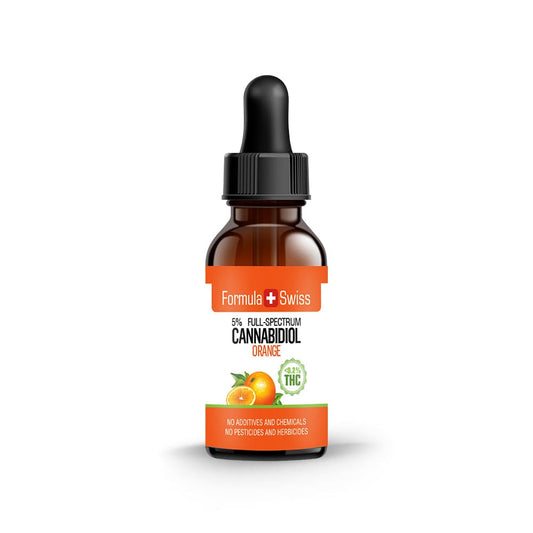When most people talk about cannabinoids, they usually mention CBD or THC. But from my experience working with hemp at Formula Swiss, I’ve found that one of the most important—yet often overlooked—compounds is CBGA, or cannabigerolic acid.
CBGA is often called the “mother cannabinoid” for a reason. It’s the first cannabinoid acid produced by the plant, and it’s from CBGA that other major compounds like CBD, THC, and CBC are formed through enzymatic reactions during the plant’s growth. Without CBGA, those well-known cannabinoids wouldn’t even exist.
Over the years, I’ve come to appreciate CBGA not just as a technical detail, but as the foundation of the plant’s chemistry. While it’s rarely present in large amounts in finished products, understanding how CBGA works has helped me better grasp how cannabinoid profiles take shape and why they vary between cultivars.
It might not be a headline ingredient, but CBGA plays a critical role in formulation and research. For me, it's where the story of the cannabis plant really begins.
Prefer watching over reading? This video covers the key points from the article:
Save up to 30% when you purchase CBD oil today
Key takeaways
- CBGA is a non-psychoactive precursor to major cannabinoids found in cannabis.
- Despite the low concentration, CBGA is vital for the formation of THC and CBD.
- It starts as the primary hemp compound from which other cannabinoids are derived.
- Cannabigerolic acid holds significant potential for future applications.
- Understanding CBGA's functions and benefits could revolutionise the use of cannabis.
This article is provided for informational purposes only and does not relate to any of the products available in our webshop. For more information, please see our full disclaimer.
Introduction to CBGA (Cannabigerolic acid)
CBGA, short for cannabigerolic acid, is an important compound found in hemp. Often described as the precursor cannabinoid, it plays a fundamental role in the formation of other cannabinoids within the cannabis plant.
One of CBGA’s notable features is its contribution to maintaining the plant’s internal balance. As the plant matures, CBGA naturally converts into other compounds through enzymatic processes, supporting the plant’s development.
Beyond its biological significance, CBGA has attracted increasing attention as interest in hemp-derived compounds continues to grow. This growing curiosity is driven by a desire to better understand its potential applications.
CBGA holds a central place in cannabis research. As knowledge of the plant expands, CBGA remains an essential focus, offering possibilities for future discoveries.
The chemical structure of CBGA
Cannabigerolic acid (CBGA) serves as the acidic precursor to primary cannabinoids such as CBD, THC, and CBG. Its chemical formula is C22H32O4, and its structure is characterised by a resorcinol core attached to a pentyl side chain, with a geranyl group connected through a carboxylated segment.

This combination results in CBGA having both a lipophilic tail and a polar acidic group, which influence its natural interactions. From a structural perspective, CBGA contains a three-ring system composed of aromatic and prenyl elements. The presence of a carboxylic acid group (-COOH) sets it apart from its decarboxylated counterpart, CBG.
Within the cannabis plant, CBGA plays a pivotal role in the biosynthesis of other cannabinoids, participating in enzymatic processes that drive their formation.
Role of CBGA as a cannabinoid precursor
CBGA (cannabigerolic acid) holds an essential place in the lifecycle of the cannabis plant, acting as the initial precursor to numerous other cannabinoids. It is produced during the plant’s early growth phase, providing the foundation for the synthesis of various cannabinoid compounds.
The role of CBGA is deeply connected to the biosynthesis process within the cannabis plant. This process starts when olivetolic acid and geranyl pyrophosphate are combined by a specific enzyme.
For example, a 2025 study published in Frontiers reported the creation of a highly active and regioselective CBGA synthase by engineering the broadly reactive prenyltransferase NphB.
The modified enzyme showed a marked improvement in catalytic efficiency, demonstrating that enzyme engineering can directly impact cannabinoid biosynthesis and create opportunities for developing new cannabinoid compounds.
Purchase CBD oil now and save as much as 30%
| Enzyme | Function | Cannabinoid produced |
|---|---|---|
| Prenyltransferase | Synthesis of CBGA from olivetolic acid and geranyl pyrophosphate | CBGA |
| THCA synthase | Conversion of CBGA to THCA | THCA |
| CBDA synthase | Conversion of CBGA to CBDA | CBDA |
| CBCA synthase | Conversion of CBGA to CBCA | CBCA |
CBGA’s role does not end with its initial formation. As the cannabis plant matures, enzymes convert CBGA into compounds such as THC, CBD, and CBC. This transformation is essential, as it determines the specific cannabinoids the plant will produce.
Researchers continue to investigate how cannabinoids are synthesised within the plant, aiming to enhance the production of CBGA and other related compounds. These could support the development of new applications. In this way, CBGA serves not only as a starting point but also as a vital component in understanding the full potential of the cannabis plant.
The studies of CBGA
Over the years, I’ve come across CBGA many times while working with hemp extracts and cannabinoid development. It rarely gets mentioned in conversations about cannabis, yet it’s where everything begins. Without CBGA, we wouldn’t have CBD, THC, or CBC. That alone makes it worth paying attention to.
One study I read from 2022, published in Function, looked at how CBGA affects store-operated calcium entry (SOCE) in immune cells. This is a pathway linked to how T-cells behave and how they release cytokines. It’s technical, but it caught my attention because it shows that CBGA might do more than just act as a chemical stepping stone—it might have its own uses worth looking into.
What I’ve seen in the industry so far tells me that CBGA’s role is bigger than most people realise. It’s not just the “mother cannabinoid.” It’s part of the deeper story behind how the plant works.

The findings showed that CBGA can influence this pathway by limiting calcium entry, which in turn alters cytokine release. These results contribute to a broader understanding of CBGA’s role in the plant's interaction with biological systems.
There is also interest in CBGA’s interaction with nerve cells, with preclinical studies examining its influence in this area. Such research seeks to expand knowledge of CBGA’s role in the plant's complex chemical makeup.
Continued scientific inquiry into CBGA is essential to further explore its properties and functions. With its foundational position in cannabinoid biosynthesis, CBGA remains a key focus for ongoing and future research efforts.
Save 30% when you order your CBD oil today
Science behind CBGA's interaction with the human body
CBGA plays an essential role in the overall function of cannabinoids. Understanding how it interacts with the human body provides valuable insights into its contribution to the plant’s broader effects.
Interaction with endocannabinoid receptors
CBGA exhibits minimal direct binding affinity with cannabinoid receptors such as CB1 and CB2, which are part of the body’s endocannabinoid system. This system is responsible for maintaining internal balance.
When CBGA engages with these receptors, it may influence various biological responses, including how the body perceives certain stimuli and regulates its internal processes.
Contribution to homeostasis and internal balance
Homeostasis refers to the body’s ability to maintain internal stability. CBGA influences the body's regulatory balance by modulating components of the endocannabinoid system.
Although it shows minimal direct interaction with cannabinoid receptors CB1 and CB2, CBGA contributes to physiological equilibrium through its action on alternative molecular targets, such as acting as a non-competitive antagonist at the GPR55 receptor and inhibiting the TRPM7 ion channel.

These interactions influence pathways related to sensory perception, cellular signalling, and overall biological regulation, contributing to the body’s internal stability.
What is the Endocannabinoid System (ECS)?
Different forms of CBGA products
CBGA products are becoming increasingly popular, with two primary types available: CBGA oils and CBGA isolates. Each offers distinct characteristics and appeals to different preferences within the market.
CBGA oils and their applications
CBGA oils are created by combining CBGA extract with a carrier such as hemp oil. This formulation is designed for ease of use and practical application. Many CBGA oils retain a full spectrum of the plant’s natural compounds, preserving the plant’s chemical profile and offering a comprehensive cannabinoid experience.
Understanding CBGA isolates
CBGA isolates are highly purified forms of CBGA, produced by separating the compound from other cannabinoids and plant materials. The result is a concentrated powder consisting solely of CBGA. These isolates are chosen by those who prefer a product containing only the isolated cannabinoid, free from additional substances.
Both CBGA oils and isolates play significant roles in the cannabinoid market, offering options that cater to different uses and preferences. Understanding these forms helps customers make informed decisions when selecting CBGA products.
| Product type | Description | Common uses |
|---|---|---|
| CBGA oil | A mix of CBGA extract and carrier oil, typically hemp oil; available in full-spectrum form. | Sublingual administration, added to foods, topical applications |
| CBGA isolate | Pure, concentrated CBGA in crystalline form. | Direct ingestion, formulation into other cannabinoid products |
CBGA's unique properties compared to other cannabinoids
CBGA holds a distinct place among cannabinoids due to its molecular structure and how it interacts with cannabinoid receptors. These factors influence its role in cannabinoid research and its various applications.
Unlike CBD and THC, CBGA’s unique chemical structure affects how it behaves within biological systems. This structural difference alters its interactions and sets it apart from other cannabinoids. Notably, CBGA, a precursor of CBG, does not produce psychoactive effects, making it an area of particular interest in scientific studies.
CBGA exhibits minimal direct interaction with the CB1 and CB2 cannabinoid receptors, which differentiates it from compounds like THC that strongly activate these sites. Despite this limited binding affinity, CBGA remains highly relevant to cannabinoid research due to its role as the biosynthetic precursor to other major cannabinoids such as THCA, CBDA, and CBCA.
| Cannabinoid | Receptor affinity | Molecular structure | Psychoactive |
|---|---|---|---|
| CBGA | Minimal (CB1 & CB2) | Carboxylic acid precursor, large & complex | No |
| CBD | Low (CB1 & CB2, indirect modulation) | Non-aromatic terpene phenol, flexible structure | No |
| THC | High (CB1 agonist, moderate CB2) | Tricyclic structure, lipophilic | Yes |
Extraction and production of CBGA
Getting CBGA from hemp is tough because it's rare in the plant. To solve these problems, new ways of breeding and extracting CBGA have been developed.
Thanks to genetic engineering, scientists can now change how microorganisms work. This has led to new ways to make cannabinoids. A big step was creating a special enzyme from Streptomyces species. It helps make more CBGA from olivetolic acid and geranyl pyrophosphate.

This new method offers a more efficient approach compared to traditional techniques for obtaining CBGA from plants. It increases CBGA yield and is well-suited for large-scale production, making it an important advancement for meeting high-volume demands.
| CBGA extraction method | Efficiency | Genetic engineering enhancement |
|---|---|---|
| Traditional hemp extraction | Low | N/A |
| Microbial synthesis with engineered enzymes | High | Engineered NphB Enzyme |
Genetic engineering has changed how we get CBGA. It's making it possible to make cannabinoids in a better and more efficient way.
Future research directions for CBGA
Looking ahead, there is growing interest in the future of CBGA research. Early investigations have highlighted its role in various biological processes, prompting scientists to explore how CBGA interacts within the human body.
Genetic engineering is improving the efficiency of CBGA production, creating new opportunities for scientific investigation. These advancements enable broader exploration of CBGA’s properties and potential applications. However, further research, including comprehensive clinical studies, is necessary to fully understand its characteristics.
CBGA presents a wide range of possibilities, and researchers are keen to investigate its many aspects. As scientific understanding grows, its role within cannabinoid research will become clearer. These ongoing studies may influence future approaches in the field. Overall, it is a promising and dynamic period for cannabinoid science.
Personal perspective
From my experience working with cannabinoids at Formula Swiss, I’ve noticed that cannabigerolic acid, or CBGA, often doesn’t get the attention it deserves, even though it plays a vital role in the cannabis plant’s development. It acts as the starting point for several other compounds and forms the true basis of the plant’s chemical makeup.
You’ll usually only find CBGA in small amounts in most hemp extracts, but I’ve seen just how important it is behind the scenes in both research and formulation work. Watching how it shifts through enzymatic processes into other well-known compounds has helped me better understand just how intricate and carefully balanced the plant really is.
For me, CBGA isn’t just something that comes before other cannabinoids. It’s more like the plant’s original blueprint. Now that producing CBGA is becoming more feasible, I think more people will start to see its value, not just in the lab but in shaping the future of cannabinoid development.
Don’t miss out—save up to 30% when you purchase CBD oil today
Frequently asked questions
What is CBGA (Cannabigerolic acid)?
CBGA is a naturally occurring acidic cannabinoid found in the early growth stages of the cannabis plant. It is often referred to as the precursor or “mother” cannabinoid because it forms the basis for other cannabinoids.
How does CBGA transform into other cannabinoids?
Through enzymatic reactions and decarboxylation, CBGA is converted into key cannabinoids such as THCA, CBDA, and CBCA. Environmental factors like heat and light can also influence this transformation.
Is CBGA psychoactive?
CBGA is not considered psychoactive and does not produce intoxicating effects. It differs from THC, which is responsible for the psychoactive properties of certain cannabis varieties.
What are the potential benefits of CBGA?
Research into CBGA is still in early stages, focusing on its chemical properties and potential applications. Scientific studies are ongoing to better understand its role within the cannabis plant.
How is CBGA different from CBG?
CBGA is the acidic form of CBG and serves as its chemical precursor. When heated, CBGA undergoes decarboxylation to become CBG, changing its molecular structure.
Is CBGA found in most CBD products?
CBGA is typically present in raw or minimally processed hemp extracts. However, it is often converted to other cannabinoids during production, making its presence in standard CBD products limited.
Does CBGA contribute to the entourage effect?
It is suggested that CBGA, like other cannabinoids, may interact with various plant compounds to influence overall effects. This interaction is an area of ongoing scientific research.
Are there any known side effects or risks with CBGA?
There is limited research on CBGA's safety profile, and no well-documented side effects have been established. Further studies are required to assess its characteristics and potential interactions.
What is CBGV (Cannabigerivarin)?






